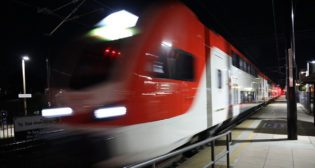
Amtrak: New Equipment Brings New Challenges
Written by Doug Riddell
The Siemens Mobility ALC-42 (Amtrak Long-Distance Charger) will replace the railroad’s aging GE Genesis fleet.
Having worked into Washington D.C. Union Station from the South my entire Amtrak career as a locomotive engineer, I’m excited yet apprehensive about the acquisition of dual-power and battery-hybrid motive power and integrated trainsets from Siemens Mobility, because it’s going to require the type of commitment to maintenance and service that’s historically been haphazard at Amtrak, at best.
On the other side of the ledger, the lengthy and bothersome change between diesel and electric locomotives at Union Station has been the chief impediment to accelerated growth of ridership between the burgeoning cities and states of the Southeast and the Northeast Corridor. Where technical assistance is but a few minutes away at any point on the NEC, once south of Washington, “You’re on your own.” Amtrak’s host railroads’ attitude toward aiding “America’s Railroad” in a time of need has ranged from tepid to belligerent. For example, finding a part for a fuel pump or an element for an auxiliary generator that is common among the host’s freight locomotive fleet and Amtrak’s existing GE Genesis power pool isn’t always easy.
For the new equipment, locating someone to actually make the repairs in the middle of the night in Savannah or Charlotte isn’t going to be impossible, but stocking those parts and retaining personnel trained to maintain those sophisticated new trainsets is going to require expertise and money.
At present, Amtrak most often relies on third-party contractors to do simple things, such as fueling diesels and dumping waste retention tanks. There are other considerations if dual-power locomotives and integrated trainsets are to be employed, such as FRA-required calendar day inspections; cab signal, train control and PTC repairs; and a myriad of other tasks that the local fuel vendor or moonlighting electrician are not licensed to perform.
Then there is the very nature of NEC vs. off-Corridor equipment design and physical operation. Grade crossing collisions are almost unheard of along the virtually sealed NEC, but they occur multiple times daily elsewhere. If a bearing fails on a wheel in a semi-permanently-coupled trainset, there won’t be the option of having the crew set out that car and resume the train’s journey, or simply wait for the next frequency to pull alongside and transfer patrons.
The Americans with Disabilities Act will also come into play. Will Amtrak be successful in getting its host railroads to accommodate high station platforms, or will these new equipment sets be designed and manufactured for the current low-platform standard of 18.5 inches above the railhead, in deference to freight equipment clearances, or both?
In essence, Amtrak will not only be acquiring hybrid equipment; it will be creating a duke’s mixture of operating practices: Corridor, off-Corridor, and something in between.
Truly, Amtrak is anxious to finally address the age-old complaints from those who wonder why American passenger trains don’t rival the speed, convenience and appearance of European and Asian train travel, and it should be applauded for doing so. However, it should plan for, and be prepared to come to grips with, the huge commitments that will inevitably come part and parcel with such a massive venture. Simply adopting a “We’ll cross that bridge when we come to it” attitude isn’t going to cut it. Let’s hope that’s not Amtrak’s strategy.

The grandson of a C&O Railroad conductor, Richmond native, and Virginia Commonwealth University mass communications graduate, Doug Riddell is a retired locomotive engineer and Amtrak company photographer, hired initially as a switchman by the Seaboard Coast Line Railroad in 1977. Riddell was a radio and television broadcaster who still does public speaking and commercial voiceover work, and is occasionally called upon to comment on railroad-related topics for network and cable television news. His exploits have served as the nexus for decades of anecdotal glimpses into the life of working railroaders that have found their way into books, magazines and documentaries. A published author, Doug’s first 1999 volume, “From The Cab: Stories From A Locomotive Engineer,” was an outgrowth of his monthly “From The Cab” column in Passenger Train Journal and RailNews. He recently completed a poignant yet comical look at the late Eugene Garfield’s original auto-train, and work is progressing on the history of its successor, Amtrak’s Auto Train. Residing in Ashland, Va., where Amtrak and CSX trains ply the main line through the center of the picturesque southern college town, Doug and his wife, Sandy, a retired educator, are first-time grandparents of twin boys, whose father, Ryan, follows in his father’s footsteps at the throttle of the Auto Train and other Amtrak runs.



